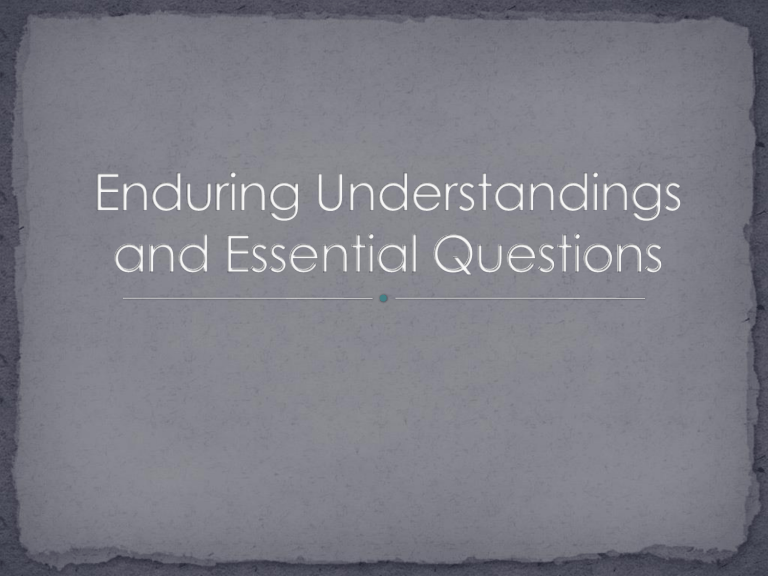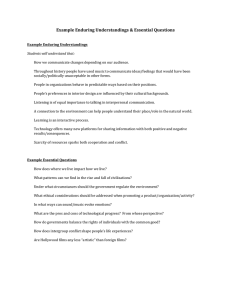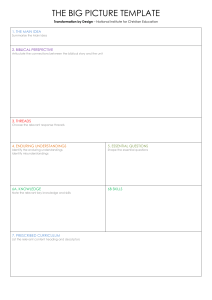
If the hypothesis…introduced is true - that any subject can be taught to any child in some honest form - then it should follow that a curriculum ought to be built around the great issues, principles, and values that a society deems worthy of the continual concern of it’s members. Jerome Bruner, The Process of Education, 1960, p. 52 Think about a unit that you teach. What standards frame the unit? What do you want your students to know and understand at the completion of the unit? New thinking around curriculum development New template built by Standards Leaders Backwards design thinking Grounded in Enduring Understandings and Essential Questions Common summative assessments Authentic performance tasks Require critical thinking, “doing the work”, demonstration of understanding, ability to frame original response(s) to essential questions What specifically do we want students to understand by unit’s end? What exactly are we trying to get students to realize that is not obvious but important? As a teacher, how do you determine what knowledge is worth understanding? Help to address the common student questions: “Why do we have to learn this?” “So what?” Can be thought of as the moral of the unit “story” as opposed to the details Help us to clarify the “why” of what we are teaching Examples of Understandings An effective story engages the reader by setting up tensions about what will happen next. A president is not above the law. Correlation does not ensure causality. Decoding is necessary but not sufficient in reading for meaning. Nonexamples of Understandings Examples of understandings Nonexamples of understandings An effective story engages the Audience and purpose reader by setting up tensions about what will happen next. A president is not above the law. The president is part of the executive branch of the US government. Correlation does not ensure causality. Things are always changing. Decoding is necessary but not sufficient in reading for meaning. Sounding out, looking at pictures Inference drawn from facts, stated as a specific and useful generalization Refer to transferable, big ideas having enduring value beyond a specific topic Involve abstract, counterintuitive, and easily misunderstood ideas Are best acquired by “uncovering” and “doing” the subject Summarize important strategic principles in skill areas Enduring Understandings_mov - YouTube3.mht Enduring Understandings MUST be connected to our Learning Standards Unpacking the standards leads you to Enduring Understandings • Some examples… Focus standards for the unit: RI 6.2 Determine a central idea of a text and how it is conveyed through particular details; provide a summary of the text distinct from personal opinions or judgments. RI6.6 Determine an author’s point of view or purpose in a text and explain how it is conveyed in the text. RH 6-8.8 Distinguish among fact, opinion, and reasoned judgment in a text. W6.2 Write informative/explanatory texts to examine a topic and convey ideas, concepts, and information through the selection, organization, and analysis of relevant content. An author conveys or explains a central idea by providing details and relevant content. An effective summary of informational text is free of personal opinions and judgments. An author of informational text tries to convey a particular point of view through relevant facts without bias. 6.G.1 Find the area of right triangles, other triangles, special quadrilaterals, and polygons by composing into rectangles or decomposing into triangles and other shapes; apply these techniques in the context of solving real-world and mathematical problems. 6.G.2 Find the volume of a right rectangular prism with fractional edge lengths by packing it with unit cubes of the appropriate unit fraction edge lengths, and show that the volume is the same as would be found by multiplying the edge lengths of the prism. Apply the formulas V= l w h and V = b h to find volumes… The area of a polygon can be determined by composing rectangles or decomposing it into triangles. Area is a measure of covering a twodimensional shape expressed in square units. The area formula comes from the perpendicular relationship of base and height. Volume is a measure of the size of a threedimensional space enclosed within or occupied by an object. The volume formula comes from the relationship between the 2-D area of the base and the height of the object. Thinking about the unit you identified at the start of the session, frame one or two Enduring Understandings that would set the purpose for the unit. How is thinking about and planning around Enduring Understandings DIFFERENT than planning strictly based on standards or objectives? How would the resulting lessons/units differ? Teaching will entail uncovering the understanding - not merely covering it – if the student is to be more than merely familiar with a claim and have insight into it’s meaning and importance. UBD Handbook, p. 86 Overarching Understandings Tend to be general Point to transferable knowledge Appropriate at multiple grade levels, various content areas Provide a link to the big ideas “So what?” Topical Understandings Tend to be more specific to a unit Identify the particular understandings we hope to cultivate about specific topics Can be “nested” under Overarching Understandings Art Art often reflects the controversial, overlooked, or taboo aspects of a culture; or novel techniques and media Unit on Impressionism Impressionist artists departed from traditional painting forms by using color, light, and shadow to convey the impression of reflected light at a particular moment Literature The modern novel overturns many traditional story elements and norms to provide a more authentic and engaging narrative. Unit using Catcher in the Rye Holden Caulfield is an alienated antihero, not simply a weird kid who mistrusts adults. History/Government Democracy requires a free and courageous press, wiling to question and investigate authority. Unit on the U.S. Constitution The Watergate incident, exposed by the press, represented a major constitutional crisis. Mathematics Mathematics allows us to see patterns that might otherwise have remained unseen. Unit on statistics Measures of central tendency enable us to find the right “average”. We should eat right and live healthy lives. We are what we eat. The three branches of government. Our founders believed in limited and divided government, in order to ensure that absolute power could never occur in government. Different countries have different cultures. Cultures develop unique traditions and norms around universal human needs (e.g. food and housing) and experiences (e.g. celebrations and mourning) Factoring and regrouping are ways to simplify. Solving problems requires simplifying expressions by finding useful equivalent statements by which unknowns and unwieldy expressions are easier to work with. Artists are always working to be creative. “Creativity is 10 percent inspiration and 90 percent perspiration.” (Pasteur) Many linear relationships can be found in the world. If you find a relationship in which two variables are related to each other in a constant ratio, the relationship can be represented graphically by a straight line What are the implications for your planning and your practice? (Break… 10 minutes!) Given particular subject matter or a particular concept, it is easy to ask trivial questions…. It is also easy to ask impossibly difficult questions. The trick is to find the medium questions that can be answered and that take you somewhere. Jerome Burner The Process of Education, 1960 Definition: A question that lies at the heart of a subject or a curriculum (as opposed to being either trivial or leading), and promotes inquiry and uncoverage of a subject. Essential questions thus do not yield a single straightforward answer (as a leading question does) but produce different plausible responses, about which thoughtful and knowledgeable people may disagree. Understanding by Design, 2nd Edition …have no one obvious right answer. …are meant to be argued. …are designed to provoke and sustain student inquiry, while focusing learning and final performances. …often address the conceptual or philosophical foundations of a discipline. …raise other important questions …naturally and appropriately recur. …stimulate vital, ongoing rethinking of big ideas, assumptions and prior lessons. ... be framed for maximal simplicity. … be worded in student-friendly language. … provoke discussion. … lead to larger essential and unit ideas. Are derived from Enduring Understandings Are NOT your daily lesson objective turned into a question format May be overarching or topical The creation of quality Essential Questions should form the basis of developing quality assessments of learning What makes essential questions important in designing meaningful, engaging learning environments? How could dealing with essential questions change the way your students approach learning? Are there any benefits from the deforestation of the rain forests? Do the benefits of deforestation outweigh the costs? What is nonfiction? How much license does a writer of nonfiction have to make a point? What is a life-changing experience? Is there a pattern to life-changing experiences? What distinguishes impressionism art? Why and how do artists break with tradition? What types of exercises will improve fitness? “No pain – no gain” – agree? How does this diet match up with the USDA nutrition recommendations? What should we eat? Craft one or two Essential Questions that would guide the learning for your unit. Given the question, what is the learning? If answers to Essential Questions cannot be found, why bother to ask them? http://www.youtube.com/watch?v=tlVuBaPVu W8&feature=related&safety_mode=true&persist _safety_mode=1&


